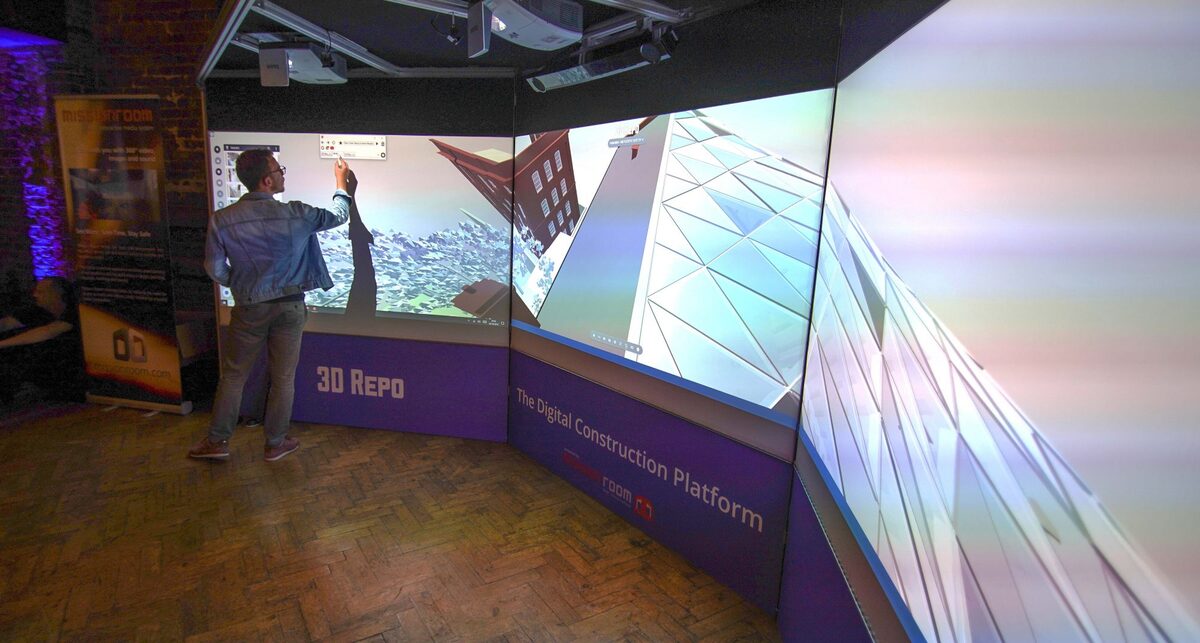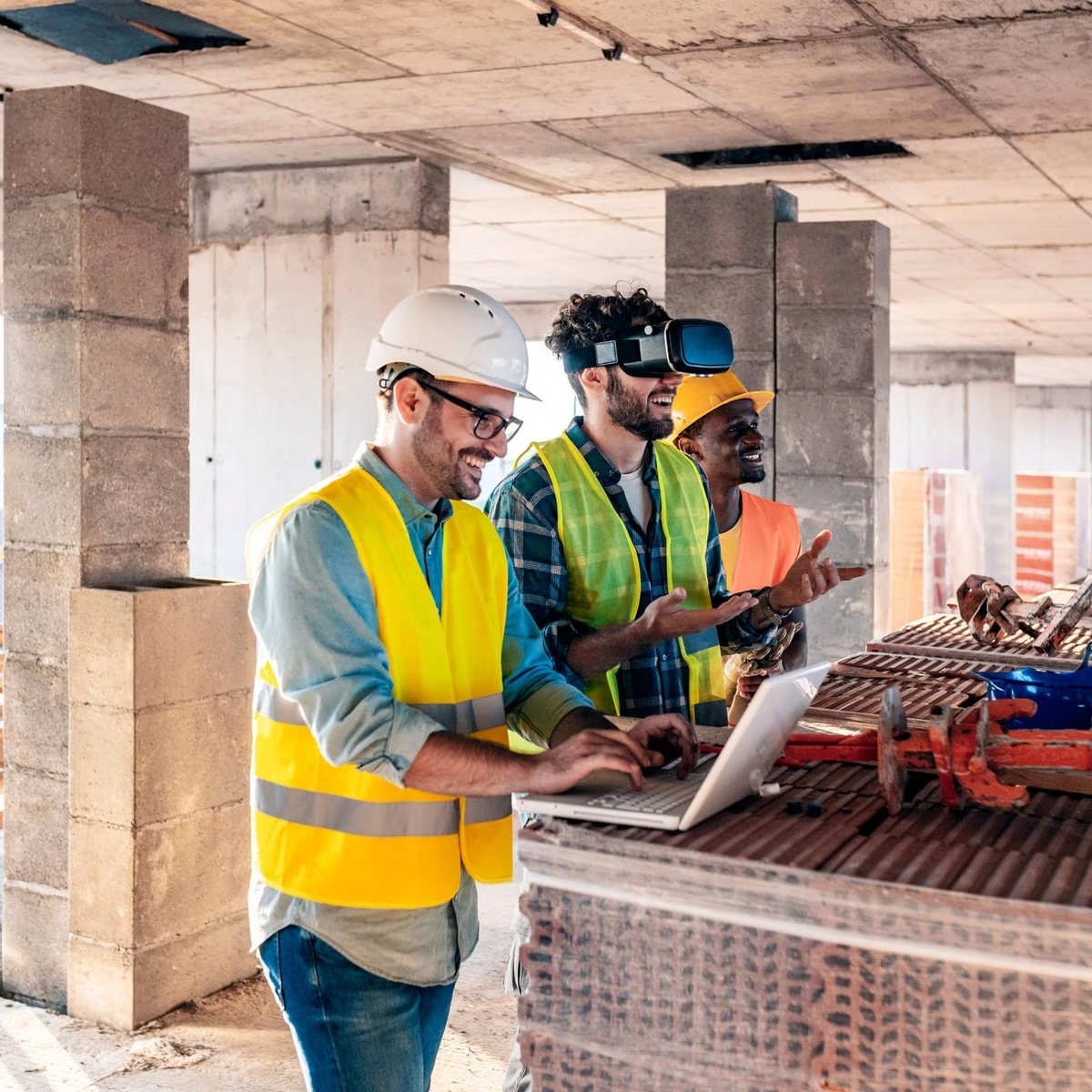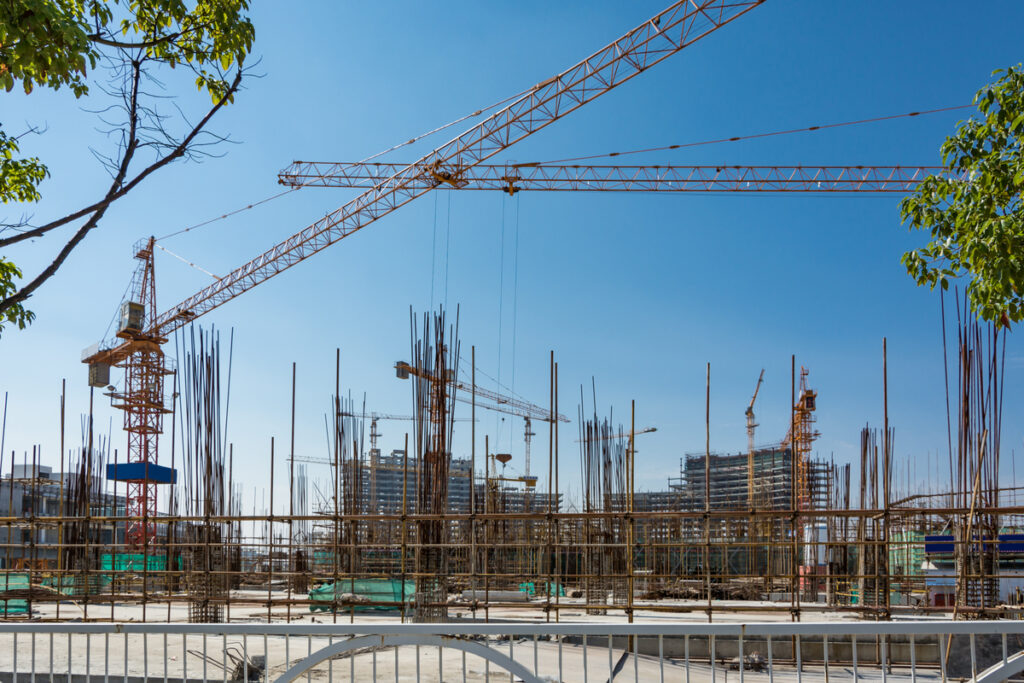Updated by Nazanin Ghodsian, 08/06/2024
Immersive construction technologies like virtual reality (VR), augmented reality (AR), and mixed reality (MR) are changing conventional methods in today’s fast-paced construction business. These cutting-edge tools are changing how stakeholders plan, work together, and complete projects, which will increase productivity and lower risk.
Immersion construction solutions are a rapidly expanding market that is expected to reach $8.9 billion by 2025 at a compound annual growth rate (CAGR) of 60.9%. The swift expansion highlights the growing acknowledgment of immersive technology as vital tool for contemporary building practices.
From planning and designing to on-site execution and safety training, immersive construction applications are vast. Virtual reality (VR) in construction enhances decision-making and engagement by enabling stakeholders to experience projects in a virtual environment. Augmented Reality (AR) in construction enhances on-site coordination and visualization by superimposing digital data over the real environment. Real-time progress tracking and collaborative design evaluations are made possible by MR in construction, which blends the virtual and physical worlds.
This guide explores the applications, benefits, and best practices for implementing immersive construction solutions. We demonstrate the revolutionary potential of these technologies and their crucial role in the future of the construction industry through real-world case studies and practical insights. Adopting these tools creates fresh chances for success and innovation in the digital age.
Table of Contents
Understanding Immersive Construction Solutions
In the rapidly evolving landscape of the construction industry, the integration of immersive technologies has emerged as a transformative force, revolutionizing traditional approaches to design, planning, and execution. Immersive construction solutions encompass a spectrum of cutting-edge technologies, including virtual reality (VR), augmented reality (AR), and mixed reality (MR), each offering unique capabilities to enhance various aspects of the construction process.
At its core, immersive construction solutions enable stakeholders to visualize and interact with digital representations of construction projects in realistic and immersive environments. Unlike traditional 2D blueprints or static 3D models, immersive technologies provide an immersive and interactive experience, allowing users to explore virtual construction sites, manipulate building components, and simulate real-world scenarios with unprecedented levels of detail and precision.
Virtual reality (VR) immerses users in fully digital environments, enabling them to navigate through virtual construction sites as if they were physically present. With VR headsets and controllers, architects, engineers, and contractors can walk through virtual buildings, inspect architectural designs, and evaluate spatial relationships from every angle. This immersive experience facilitates better communication, collaboration, and decision-making throughout the project lifecycle.
Augmented reality (AR) overlays digital information onto the physical world, blending virtual elements with the real environment. In construction, AR applications superimpose 3D models, plans, and data onto job sites, enabling workers to visualize proposed designs in the context of the actual construction site. From guiding onsite assembly to detecting clashes between design elements, AR enhances accuracy and efficiency while reducing errors and rework.
Suggested article to read: AR for Facility Management
Mixed reality (MR) combines elements of both VR and AR, seamlessly integrating virtual content with the physical environment in real-time. MR devices, such as Microsoft HoloLens, allow users to interact with holographic representations of building components within the context of the physical world. This spatial computing technology enables collaborative design reviews, onsite training simulations, and real-time progress monitoring, empowering construction teams to work more efficiently and effectively.
The benefits of immersive construction solutions extend beyond visualization and simulation. By facilitating immersive experiences, these technologies enhance stakeholder engagement, improve decision-making processes, and mitigate risks associated with design errors and construction conflicts. Moreover, immersive solutions enable remote collaboration and training, enabling global teams to collaborate seamlessly and access training resources from anywhere in the world.
However, the adoption of immersive construction solutions is not without its challenges. From initial investment costs to technical complexities and integration hurdles, implementing immersive technologies requires careful planning, resources, and expertise. Furthermore, ensuring compatibility and interoperability between different software platforms and hardware devices can pose additional challenges for construction firms.
In conclusion, understanding immersive construction solutions is essential for navigating the complexities of modern construction projects and unlocking new opportunities for innovation and growth. By embracing VR, AR, and MR technologies, construction professionals can revolutionize their workflows, streamline collaboration, and deliver projects more efficiently and effectively than ever before. As the construction industry continues to evolve, immersive solutions will undoubtedly play a pivotal role in shaping its future trajectory towards greater productivity, sustainability, and success.

Applications of Immersive Construction Solutions
Immersive construction solutions, including virtual reality (VR), augmented reality (AR), and mixed reality (MR), offer a plethora of applications that revolutionize traditional construction processes. These technologies have transformed the way stakeholders conceptualize, plan, design, and execute construction projects, leading to enhanced efficiency, accuracy, and collaboration across the board. Below are some key applications of immersive construction solutions:
- Design and Planning: Immersive technologies provide architects, engineers, and designers with powerful tools for conceptualizing and refining building designs. VR enables stakeholders to immerse themselves in virtual environments, allowing for real-time exploration of spatial relationships, material selections, and aesthetic considerations. AR overlays digital designs onto physical spaces, facilitating on-site design reviews and contextual analysis. MR in construction combines the benefits of both VR and AR, enabling users to interact with holographic representations of building components within real-world environments.
- Visualization and Communication: Immersive construction solutions improve communication and visualization throughout the project lifecycle. By creating immersive experiences, stakeholders can better understand complex design concepts, identify potential issues, and communicate their ideas effectively. VR walkthroughs and fly-throughs provide clients and stakeholders with a realistic preview of the final product, enhancing engagement and buy-in. AR annotations and overlays enable field workers to access relevant information directly within the context of the construction site, improving comprehension and productivity.
- Training and Simulation: Immersive technologies are invaluable for training construction workers and simulating on-site scenarios in a safe and controlled environment. VR-based training simulations allow workers to practice tasks, such as equipment operation, hazard recognition, and emergency response, without exposing them to real-world risks. AR-based guidance systems provide step-by-step instructions and visual cues to assist workers during complex assembly or installation tasks, reducing errors and improving efficiency.
- On-site Construction Management: Immersive construction solutions enhance on-site construction management by providing real-time access to project information and enabling better decision-making. AR-based construction management platforms overlay digital models, schedules, and data onto the physical job site, allowing project managers to visualize progress, identify issues, and coordinate activities more effectively. MR headsets equipped with spatial computing capabilities enable construction teams to collaborate remotely, visualize 3D models in situ, and access relevant information hands-free, improving communication and productivity on-site.
- Safety and Risk Assessment: Immersive technologies play a crucial role in enhancing safety and risk assessment in construction projects. VR-based safety training simulations allow workers to experience hazardous scenarios, such as falls, collapses, or equipment failures, in a realistic and immersive environment, promoting better hazard awareness and prevention. AR-based safety inspections enable inspectors to overlay digital checklists and guidelines onto physical structures, facilitating comprehensive inspections and documentation of safety compliance.
- Marketing and Client Presentations: Immersive construction solutions offer innovative ways to showcase construction projects and engage clients. VR-based virtual tours allow potential buyers and investors to explore unbuilt properties, visualize design options, and experience different spaces before construction begins. AR-based marketing campaigns leverage interactive experiences, such as augmented reality apps or outdoor installations, to promote construction projects and attract potential buyers or tenants.
In summary, immersive construction solutions have a wide range of applications across various stages of the construction lifecycle, from design and planning to on-site execution and marketing. By harnessing the power of VR, AR, and MR technologies, construction professionals can streamline workflows, improve collaboration, enhance safety, and deliver projects more efficiently and effectively than ever before. As these technologies continue to evolve, their potential to reshape the construction industry and drive innovation remains limitless.

Case Studies
Here are a few case studies that illustrate the real-world impact of immersive construction solutions:
1. Skanska’s Usage of Virtual Reality for Project Visualization
Overview: Skanska, one of the world’s leading construction companies, implemented virtual reality (VR) technology to enhance project visualization and stakeholder engagement.
Case Study: Skanska utilized VR to create immersive walkthroughs of their construction projects, allowing clients and stakeholders to experience the design in a realistic virtual environment. By providing stakeholders with interactive VR experiences, Skanska improved communication, minimized misunderstandings, and expedited decision-making processes. This approach significantly enhanced client satisfaction and project outcomes, leading to increased project efficiency and reduced costs.
2. BIM Coordination with Augmented Reality at Turner Construction
Overview: Turner Construction, a prominent construction management company, leveraged augmented reality (AR) technology to streamline building information modeling (BIM) coordination on a complex healthcare construction project.
Case Study: Turner Construction implemented AR-based BIM coordination tools to overlay 3D models and design data onto the physical construction site. This enabled field workers to visualize clash detections, identify potential conflicts, and resolve issues in real-time. By integrating AR into their BIM coordination workflow, Turner Construction improved collaboration between project teams, reduced construction rework, and accelerated project timelines. The use of AR technology resulted in significant cost savings and enhanced project efficiency.
3. Suffolk Construction’s Mixed Reality Safety Training Program
Overview: Suffolk Construction, a leading construction management firm, developed a mixed reality (MR) safety training program to enhance worker safety and hazard awareness on construction sites.
Case Study: Suffolk Construction created an MR-based safety training simulation that replicated hazardous scenarios, such as falls from heights or scaffold collapses, in a realistic virtual environment. Workers were immersed in these simulations using MR headsets, allowing them to experience and respond to safety hazards in a safe and controlled setting. The MR safety training program significantly improved worker hazard awareness, reduced workplace accidents, and enhanced overall safety culture on Suffolk Construction’s construction sites. As a result, Suffolk Construction achieved a notable decrease in lost-time incidents and injury rates.
Suggested article to read: Construction Site Safety | Construction Safety Sensors
These case studies demonstrate the tangible benefits of implementing immersive construction solutions in real-world construction projects. By embracing technologies such as virtual reality, augmented reality, and mixed reality, construction companies can improve project visualization, streamline coordination, enhance safety training, and ultimately deliver projects more efficiently and effectively.
Best Practices for Implementing Immersive Solutions
Implementing immersive solutions in the construction industry requires careful planning, strategic implementation, and adherence to best practices to ensure successful adoption and maximum benefit. Here are some best practices for implementing immersive solutions:
- Define Clear Objectives: Clearly define the objectives and goals you aim to achieve with immersive solutions. Whether it’s improving collaboration, enhancing visualization, or increasing efficiency, having a clear understanding of the desired outcomes will guide the implementation process.
- Assess Technology Requirements: Evaluate the technology requirements based on your project needs and objectives. Determine whether virtual reality (VR), augmented reality (AR), or mixed reality (MR) solutions are most suitable for your use case. Consider factors such as hardware specifications, software compatibility, and integration with existing systems.
- Invest in Training and Education: Provide comprehensive training and education to stakeholders involved in using immersive solutions. Ensure that users are proficient in operating the hardware and software, navigating virtual environments, and leveraging immersive tools effectively. Continuous education and upskilling are essential for maximizing the benefits of immersive technology.
- Start with Pilot Projects: Begin with pilot projects or small-scale implementations to test the feasibility and effectiveness of immersive solutions in real-world scenarios. Pilot projects allow you to identify potential challenges, fine-tune processes, and gather feedback from users before scaling up to larger projects.
- Collaborate Across Disciplines: Foster collaboration and communication across different disciplines within the construction project team. Involve architects, engineers, contractors, and clients in the decision-making process to ensure that immersive solutions meet the needs and requirements of all stakeholders. Collaborative planning and execution are key to successful implementation.
- Integrate Immersive Solutions into Workflows: Integrate immersive solutions seamlessly into existing construction workflow and processes to minimize disruption and maximize efficiency. Identify specific tasks or phases of the construction project where immersive technologies can add value and incorporate them into established workflows. Streamline data exchange and collaboration between different software platforms to ensure smooth operation.
- Focus on Usability and User Experience: Prioritize usability and user experience when designing immersive applications and interfaces. Strive for intuitive navigation, clear instructions, and user-friendly interactions to minimize learning curves and maximize user adoption. Solicit feedback from end-users and iterate on the design based on their input to enhance usability.
- Ensure Data Security and Privacy: Implement robust security measures to protect sensitive project data and ensure user privacy when using immersive solutions. Encrypt data transmissions, restrict access to authorized users, and comply with relevant data protection regulations to safeguard confidential information and maintain trust among stakeholders.
- Measure Performance and ROI: Establish key performance indicators, Construction KPIs, to track the performance and return on investment (ROI) of immersive solutions. Monitor metrics such as productivity gains, cost savings, error reduction, and stakeholder satisfaction to evaluate the impact of immersive technology on construction projects. Use data-driven insights to refine strategies and optimize future implementations.
- Stay Updated on Emerging Technologies: Stay abreast of advancements in immersive technologies and emerging trends in the construction industry. Continuously evaluate new tools, platforms, and applications to identify opportunities for innovation and improvement. Embrace a culture of innovation and adaptability to remain competitive in a rapidly evolving landscape.
By following these best practices, construction companies can effectively implement immersive solutions and harness the full potential of virtual reality, augmented reality, and mixed reality technologies to drive efficiency, collaboration, and innovation in construction projects.

Conclusion
In the fast-paced realm of construction, the integration of immersive technologies marks a paradigm shift, redefining traditional practices and ushering in a new era of innovation. From virtual reality (VR) to augmented reality (AR) and mixed reality (MR), these immersive construction solutions empower stakeholders to visualize, interact with, and understand projects in ways previously unimaginable.
Immersive technologies offer a multifaceted approach to construction, enabling stakeholders to delve into digital realms where designs come to life with unparalleled realism. VR immerses users in fully digital environments, providing architects, engineers, and contractors with immersive walkthroughs and precise spatial understanding. AR overlays digital information onto the physical world, revolutionizing on-site visualization and communication. MR merges virtual and physical realities, allowing for collaborative design reviews and real-time progress monitoring.
The applications of immersive construction solutions are vast and impactful. From streamlining design and planning processes to enhancing on-site construction management and safety training, these technologies have revolutionized every facet of the construction lifecycle. Real-world case studies, such as Skanska’s VR-enhanced project visualization and Suffolk Construction’s MR-based safety training program, underscore the tangible benefits and transformative potential of immersive solutions.
However, successful implementation requires careful planning, collaboration, and adherence to best practices. By defining clear objectives, assessing technology requirements, and investing in training and education, construction companies can ensure a seamless transition to immersive solutions. Starting with pilot projects, integrating immersive solutions into workflows, and prioritizing usability and user experience are essential steps for driving adoption and maximizing benefits.
As construction professionals embrace immersive technologies, they are poised to unlock new opportunities for innovation, collaboration, and efficiency. By staying updated on emerging technologies and continuously refining their strategies, construction companies can position themselves at the forefront of industry transformation. In conclusion, understanding and embracing immersive construction solutions are essential for navigating the complexities of modern construction projects and shaping the future of the industry. Through strategic implementation and a commitment to best practices, construction firms can harness the full potential of immersive technologies to drive success and achieve unparalleled results in the dynamic landscape of construction.
FAQs
What is Immersive Construction?
- Answer: Immersive construction uses VR, AR, and MR technologies to enhance visualization, collaboration, and execution in construction projects by creating interactive virtual environments.
How does Virtual Reality Benefit Construction Projects?
- Answer: VR allows stakeholders to visualize projects in detail before they are built, improving decision-making and stakeholder engagement while identifying potential issues early.
How can Immersive Construction Improve Safety on Construction Sites?
- Answer:Immersive technologies like VR and AR provide safety training by simulating hazardous scenarios, preparing workers for potential risks without actual exposure.
Suggested article for reading:
Futuristic Construction; Everything You need to know in 2024
Building Digitalization; Comprehensive Guide 2024
Resources:
IOP Science | MDPI | Reddit | Immersion Data Solution | Razor Ltd | Frontiers | Autodesk | Skanska | Researchgate
For all the pictures: BSI | 360 Immersive | PBC Today | Vection Technologies



